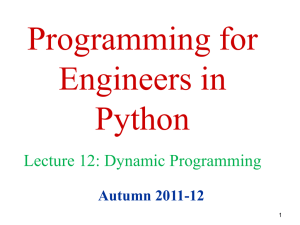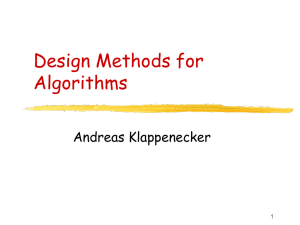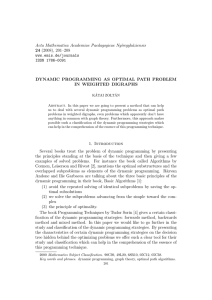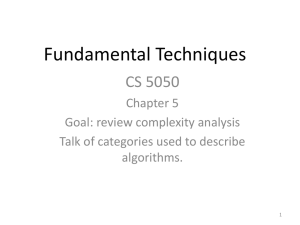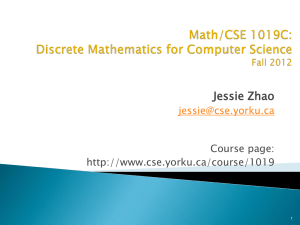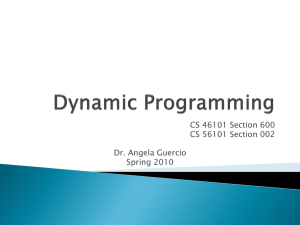Dynamic Programming: Data Structures & Algorithms
advertisement
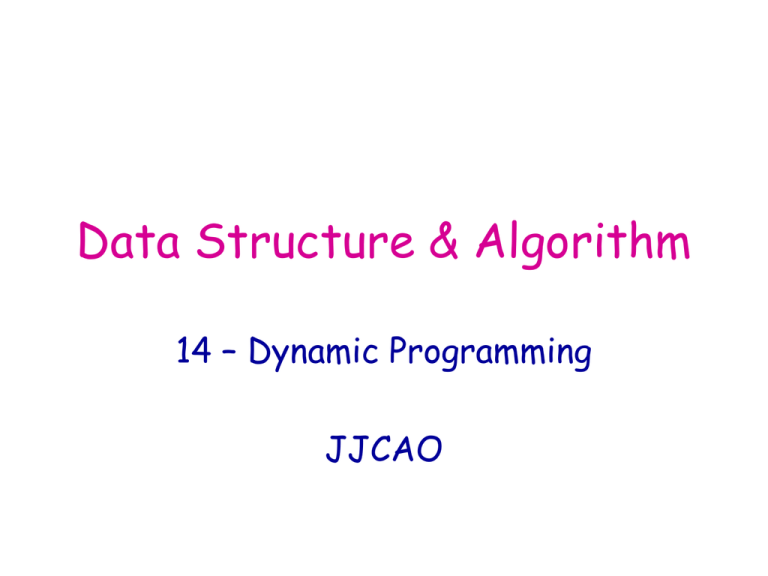
Data Structure & Algorithm
14 – Dynamic Programming
JJCAO
2
Overview
•
•
•
•
•
•
What is DP?
Characteristics of DP
Formulation
Examples
Disadvantages of DP
References
WHAT IS DP?
• Dynamic Programming (DP) is a commonly used method of optimally
solving complex problems by breaking them down into simpler
subproblems in a recursive manner.
• Dynamic programming is both a mathematical optimization method
and a computer programming method. It is applicable to both
discrete and continuous domains.
• Floyd’s all-pairs shortest-path algorithm was an example of dynamic
programming.
Richard Bellman pioneered the systematic
study of dynamic programming in the 1950s.
3
4
Applied_Dynamic_Programming_1962
2010
Also known for:
• Hamilton–Jacobi–Bellman equation
Discrete: Bellman equation in optimal control
Continuous: Hamilton–Jacobi equation in classical physics
• Curse of dimensionality
E.G. Evenly-spaced sample points of 1d interval, 2d image,
10d hypercube, …
• Bellman–Ford algorithm
Dijkstra’s algorithm is faster with non-negative weights
http://bellmanequation.com
2010
5
Greedy vs. Exhaustive Search
• Greedy algorithms focus on making the best local choice
at each decision point. In the absence of a correctness
proof such greedy algorithms are very likely to fail.
• Dynamic programming gives us a way to design custom
algorithms which systematically search all possibilities
(thus guaranteeing correctness) while storing results to
avoid recomputing (thus providing efficiency).
• Once understood it is relatively easy to apply, it looks like
magic until you have seen enough examples.
Applications
Once you understand dynamic programming, it is usually
easier to reinvent certain algorithms than try to look
them up!
Steven Skiena had found dynamic programming to be one
of the most useful algorithmic techniques in practice:
•
•
•
•
Shortest path on a DAG
Morphing in computer graphics.
Data compression for high density bar codes.
Designing genes to avoid or contain specified patterns.
•
•
•
•
•
Knapsack (0/1, integer)
Matrix Chain multiplication problem
Longest common subsequence
VLSI CAD problems, e.g., Gate sizing, Placement, Routing etc.
Queuing theory, Control theory, Bioinformatics, Information theory,
Operations Research etc.
Multiple-class Mean Value Analysis (MVA) etc.
•
6
CHARACTERISTICS OF DP
• DP is applicable to problems that exhibit the properties of
overlapping subproblems which are only slightly smaller and
optimal substructure.
• Overlapping subproblems
– If overlapping problems are much smaller than the original problem,
the strategy is called “divide and conquer”, such as mergesort,
quicksort.
• Optimal substructure
– the solution to a given optimization problem can be obtained by the
combination of optimal solutions to its subproblems
– usually described by means of recursion
7
Overlapping subproblems
A naive implementation of finding nth Fibonacci number is :
Function fib(n)
if n =0 return 0
else if n =1 return 1
else return fib(n-1) + fib (n-2)
But this involves repeated calculations –for higher numbers it
leads to exponential time!!!
8
How slow?
• Question: Find tow numbers in [1,999], satisfying that the
ratio is most close to the golden ratio 𝜑.
• lim 𝐹𝑛+1 /𝐹𝑛 = 𝜑
𝑛
• 𝐹𝑛 ≈ 1.6𝑛
• Since our recursion tree has 0 and 1 as leaves,
computing 𝐹𝑛 requires ≈ 1.6𝑛 calls!
9
Overlapping subproblems
10
• Top-down approach of DP: Memorize and use solutions of previously
solved subproblems
Function fib(n)
if n =0 return 0
else if n =1 return 1
else return fib(n-1) + fib (n-2)
FIB = -ones(n,1);
FIB[0]=0; FIB[1]=1;
Function fib(n)
if FIB(n) < 0 return fib(n-1) + fib (n-2)
else return FIB(n);
• Moral: we traded space for time. O(n) is the time complexity and O(n) is
space complexity, compared to exponential complexity of naïve method.
Overlapping subproblems
• Bottom-up approach of DP: Memorize by solving the subproblems first
and use their solutions to build-on and arrive at solutions to bigger
subproblems
Moral: we traded space for time.
Function fib(n)
Var previousFib:= 0,
currentFib:= 1
if n =0 return 0
else if n = 1 return 1
repeat n-1 times
Var newFib:= previousFib+
currentFib
previousFib:= currentFib
currentFib:= newFib
return currentFib
• O(n) is the time complexity and O(1) is space complexity, compared to
exponential complexity of naïve method.
11
Overlapping subproblems
12
• Dynamic programming is a technique for avoiding recomputation by
storing partial results
• The trick to dynamic program is to see that the naive recursive
algorithm repeatedly computes the same subproblems over and over and
over again. If so, storing the answers to them in a table instead of
recomputing can lead to an efficient algorithm.
– Top-down approach: memorize or store the solutions to the subproblems in a table.
Whenever we attempt to solve a new subproblem, we first check the table to see if it is
already solved. If a solution has been recorded, we can use it directly, otherwise we
solve the subproblem and add its solution to the table.
– Bottom-up approach: Once we formulate the solution to a problem recursively as in terms
of its subproblems, we can try reformulating the problem in a bottom-up fashion: try solving
the subproblems first and use their solutions to build-on and arrive at solutions to
bigger subproblems. This is also usually done in a tabular form by iteratively generating
solutions to bigger and bigger subproblems by using the solutions to small subproblems. For
example, if we already know the values of F41 and F40, we can directly calculate the value of
F42.
• Thus we must first hunt for a correct recursive algorithm – later we can
worry about speeding it up by using a results matrix.
Binomial Coefficients
13
𝑛
𝑛!
•
=
counts the number of ways to choose k
𝑛−𝑘 !𝑘!
𝑘
things out of n possibilities.
• intermediate calculations can easily cause arithmetic
overflow even when the final coefficient fits comfortably
within an integer
• A more stable way:
𝑛
𝑛−1 𝑛−1
𝑛−2 𝒏−𝟐
𝒏−𝟐 𝑛−2
=
+
=
+
+
+
=...
𝑘
𝑘
𝑘−1
𝑘
𝒌−𝟏
𝒌−𝟏
𝑘−2
Pascal’s Triangle
Binomial Coefficients Implementation
14
Three Steps to Dynamic Programming
1. Formulate the answer as a recurrence
relation or recursive algorithm.
2. Show that the number of different
instances of your recurrence is bounded
by a polynomial.
3. Specify an order of evaluation for the
recurrence so you always have what you
need.
15
16
Optimal Substructure - Shortest path example
• To find the shortest path to D:
If the shortest path involves to D involves the path from S to D has the node C,
then the shortest path from S to C and shortest path from C to D are the
optimal subsolutions of the actual problem.
Example 0: Rod cutting
17
Given a rod of length n inches and a table of prices pi for i, determine the
maximum revenue 𝑟𝑛 obtainable by cutting up the rod and selling the pieces.
n<=10, in the table:
We can cut up a rod of length n in 2𝑛−1 different ways
The 8 possible ways of cutting up a rod of length 4. Above each
piece is the value of that piece, according to the sample price chart.
The optimal strategy is part (c)—cutting the rod into two pieces of
length 2—which has total value 10
Rod cutting
18
• we can frame the values 𝑟𝑛 for n>=1 in terms of optimal revenues from
shorter rods
• In a related, but slightly simpler, way to arrange a recursive structure
for the rod cutting problem, we view a decomposition as consisting of
a first piece of length i cut off the left-hand end, and then a righthand remainder of length n-i. Only the remainder, and not the first
piece, may be further divided.
• A straightforward, top-down, recursive implementation:
CUT-ROD(p,n)
The recursion tree showing recursive calls
resulting from a call CUT-ROD(p,n) for n=4.
In general, this recursion tree has 2^n nodes
and 2^(n-1) leaves.
• the running time of CUT-ROD is exponential in n.
19
20
Dynamic programming for optimal rod cutting
The subproblem graph for the
rod-cutting problem with n
The running time of BOTTOM-UP-CUT-ROD is O(n^2)
Reconstructing a solution
s[1..n]: optimal first-piece sizes
prints out the complete list of piece sizes in an optimal decomposition
of a rod of length n:
A call to PRINT-CUT-ROD-SOLUTION(p,10) would print just 10, but a
call with n=7 would print the cuts 1 and 6, corresponding to the optimal
decomposition for r_7
21
Example 1: The Partition Problem
22
Suppose the job scanning through a shelf of books is to be
split between k workers.
No sort is permitted here!
To avoid the need to rearrange the books or separate them into
piles, we can divide the shelf into k regions and assign each
region to one worker.
What is the fairest way to divide the shelf up?
If each book is the same length, partition the books into equalized
regions,
100 100 100 | 100 100 100 | 100 100 100
But what if the books are not the same length? This partition
would yield
400 500 600 | 100 200 300 | 700 800 900
23
The Linear Partition Problem
Input: A given arrangement S of nonnegative
numbers {s1, . . . , sn} and an integer k.
Problem: Partition S into k ranges, so as to
minimize the maximum sum over all the ranges.
E.g. n=9,k=3, the maximum sum is 1700: 100 200
300 400 500 | 600 700 | 800 900
Try to find an algorithm which always gives the
optimal solution.
Recursive Idea
• Consider a recursive, exhaustive search approach. Notice
that the kth partition starts right after we placed the (k −
1)st divider.
• What is the cost of this? The total cost will be the larger
of two quantities
𝐶[𝑛, 𝑘]=max(C[i,k-1],
1.
the cost of the last partition
𝑛
𝑗=𝑖+1 𝑠𝑗 )
𝑛
𝑗=𝑖+1 𝑠𝑗
2. the cost of the largest partition cost formed to the left of i
24
Dynamic Programming Recurrence
25
Define M[n, k] to be the minimum possible cost over all partitionings of
{s1, . . . , sn} into k ranges, where the cost of a partition is the largest sum
of elements in one of its parts. Thus defined, this function can be
evaluated:
with the natural basis cases of
For computing M[n,k], you need to memorize a n*(k-1) table
𝑀[1,1] 𝑀[1,2]
𝑀[2,1] 𝑀[2,2] 𝑀[2,3]
𝑀[1, 𝑘 − 1]
𝑀[2, 𝑘 − 1]
𝑀[𝑛, 1]
𝑀[𝑛, 𝑘 − 1]
Running time (a total of kn cells, each cell depends on n others): O(kn^2)
Implementation
26
To evaluate this efficiently, we must make sure we do the
smaller cases before the larger cases that depend upon them.
Partition[S, k]
(* compute prefix sums: p[k] = 𝑛𝑖=1 𝑠𝑖 *)
p[0] = 0
for i = 1 to n do p[i] = p[i − 1] + si
(* initialize boundary conditions *)
for i = 1 to n do M[i, 1] = p[i]
for i = 1 to k do M[1, j] = s1
(* evaluate main recurrence *)
27
28
DP Matrices
29
Example 2: OPTIMAL MATRIX MULTIPLICATION ORDER
• General problem: Determine the optimal order of A1xA2xA3x… xAn
• Subproblems : AixAi+1x… Aj, 1<= i <= j <= n
• Define C(i,j) = minimum cost of multiplying Ai xAi+1x… Aj
The cost of the subproblemis the cost of these two pieces and the cost of
combining them
30
The pseudo code
• The complexity of O(n^3).
Example 3: KNAPSACK PROBLEM
《在云端》背包理论.mp4
31
0/1 KNAPSACK PROBLEM
•
•
•
•
32
Given n objects and a “knapsack”.
Item I weights wi> 0 Kgs & has value vi> 0.
Knapsack has capacity of W Kgs.
Goal: fill knapsack so as to maximize its total value.
• OPT(i,w) = max profit subset of items 1…i with weight
limit w
max{𝑂𝑃𝑇 𝑖 − 1, 𝑤 , 𝑣𝑖 + 𝑂𝑃𝑇(𝑖 − 1, 𝑤 − 𝑤𝑖 }
OPT(i,w) = 𝑂𝑃𝑇 𝑖 − 1, 𝑤
0
if 𝑤𝑖 <=w
if 𝑤𝑖 >w
if i=0
Running time: O(n*W)
33
What is DP?
1. Recurrent/recursive formula
2. Starting states
DP solutions have a polynomial complexity
with assures a much faster running time
than backtracking, brute-force etc.
Example 4
34
• Given a list of N coins, their values (V1, V2, ... , VN), and the total sum S.
• Find the minimum number of coins the sum of which is S: m[s] (we can
use as many coins of one type as we want),
• or report that it's not possible to select coins in such a way that they
sum up to S.
m[i]=min{𝑚 𝑖 − 𝑣𝑗 + 1}
𝑗
m[0]=0
Set Min[i] equal to Infinity
for all of i Min[0]=0
For i = 1 to S
For j = 0 to N - 1
If (Vj<=i AND Min[i-Vj]+1<Min[i])
Then Min[i]=Min[i-Vj]+1
Output Min[S]
Example: Given coins with values 1, 3, and 5. And S=11.
Example 5
35
• Given a sequence of N numbers - A[1] , A[2] , ..., A[N] . Find the length
of the longest non-decreasing sequence m[N].
• m[i]: len of longest non-decreasing sequence which has its last number
A[i]
𝑚 𝑗 + 1, 𝐴[𝑗] < 𝐴[𝑖]
m[i]=max{
}
𝑗<𝑖
𝑚𝑗,
𝑜𝑡ℎ𝑒𝑟𝑤𝑖𝑠𝑒
m[1]=1
• Example: 5, 3, 4, 8, 6, 7
36
More 1D DP examples
TopCoder competitions
• ZigZag - 2003 TCCC Semifinals 3
• BadNeighbors - 2004 TCCC Round 4
• FlowerGarden - 2004 TCCC Round 1
Example 6
• Problem: A table composed of N x M cells, each having a
certain quantity of apples, is given. You start from the
upper-left corner. At each step you can go down or right
one cell. Find the maximum number of apples you can
collect.
• S[i][j] is max number collected when you arrived [i,j]
S[i][j]=A[i][j] + max(S[i-1][j], if i>0 ; S[i][j-1], if j>0)
S[0][0]=0;
S[0][j]=A[0][j]+S[0][j-1]
S[i][0]=A[i,0]+S[i-1][0]
*
For i = 0 to N - 1
For j = 0 to M - 1
S[i][j] = A[i][j] + max(S[i][j-1], if j>0 ; S[i-1][j], if
i>0 ; 0)
Output S[n-1][m-1]
37
38
More 2D DP examples
TopCoder competitions
• AvoidRoads - 2003 TCO Semifinals 4
• ChessMetric - 2003 TCCC Round 4
Example 7
39
Given an undirected graph G having positive weights and N vertices.
You start with having a sum of M money. For passing through a vertex i, you
must pay S[i] money. If you don't have enough money - you can't pass
through that vertex. Find the shortest path from vertex 1 to vertex N,
respecting the above conditions; or state that such path doesn't exist.
Restrictions: 1<N<=100 ; 0<=M<=100 ; for each i, 0<=S[i]<=100
Pseudocode
Set dist[i][j] to Infinity for all (i,j)
dist[0][M]=0
While(TRUE)
(d,k,l)=min{dist[i][j]}
If (d== Infinity) break;
For All Neighbors p of Vertex k.
If (l-S[p]>=0 && dist[p][l-S[p]]>dist[k][l]+weight[k][p])
Then dist[p][l-S[p]]=dist[k][l]+weight[k][p]
End For
End While
Find the smallest number among dist[N-1][j] (for all j, 0<=j<=M); if there
are more than one such states, then take the one with greater j.
If there are no states(N-1,j) with value less than Infinity - then such a
path doesn't exist.
40
41
More TC problems for practicing
•
•
•
•
Jewelry - 2003 TCO Online Round 4
StripePainter - SRM 150 Div 1
QuickSums - SRM 197 Div 2
ShortPalindromes - SRM 165 Div 2
DISADVANTAGES OF DP
42
“Curse of dimensionality” –Richard Bellman:
• Runtime is strongly dependent on the range of state variable ( example
the weight capacity W of the knapsack), so we cannot guarantee bounds
on the runtime.
• Problems involving fractional state variable values can lead exponential
increase in the iterations (time complexity).
• The storage space (space complexity) is strongly dependent on the
state variable and can also be .
• Is only applicable to problems with identified overlapping subproblems
and optimal substructures. Many problems use using dynamic
programming locally to solve the larger problem.
• Establishing/identifying the optimal substructure and the DP recursion
is not a trivial task for large problems.
43
References
• Thomas H. Cormen, Charles E. Leiserson, Ronald L. Rivest, Clifford
SteinIntroduction to Algorithms_3rd.
• http://en.wikipedia.org/wiki/Dynamic_programming
• R. Bellman, Dynamic Programming. Dover Publications, N.Y, 1957.
• Bellman, R. and S. Dreyfus (1962) Applied Dynamic Programming
Princeton University Press Princeton, New Jersey.
• Blackwell, D. (1962) Discrete Dynamic Programming. Annals of
Mathematical Statistics 33, 719-726.
• Chow, C.S. and Tsitsiklis, J.N. (1989) The Complexity of Dynamic
Programming. Journal of Complexity 5 466.488.
• Eric V. Denardo Dynamic programming: models and applications, 2003.
• www.cs.berkeley.edu/~vazirani/algorithms/chap6.pdf
• http://www2.fiu.edu/~thompsop/modeling/modeling_chapter5.pdf
• http://mat.gsia.cmu.edu/classes/dynamic/dynamic.html

